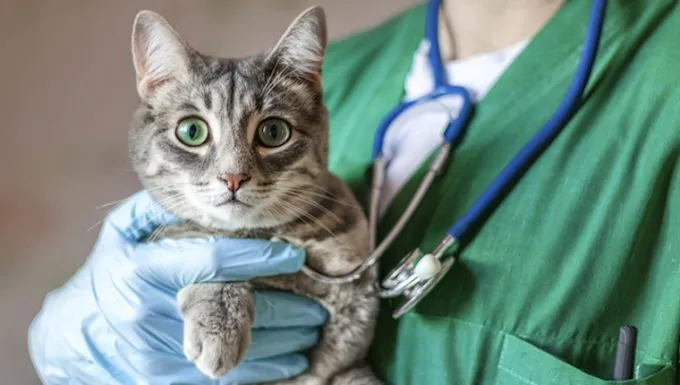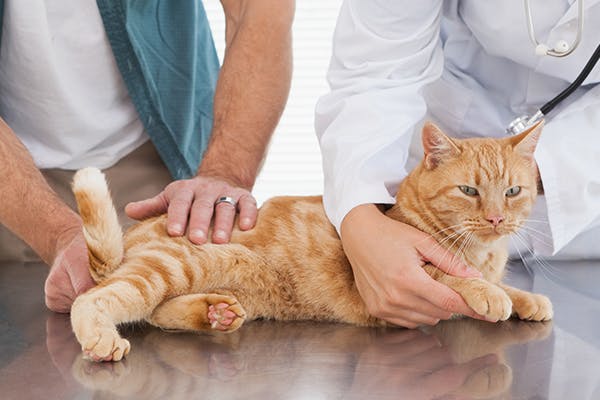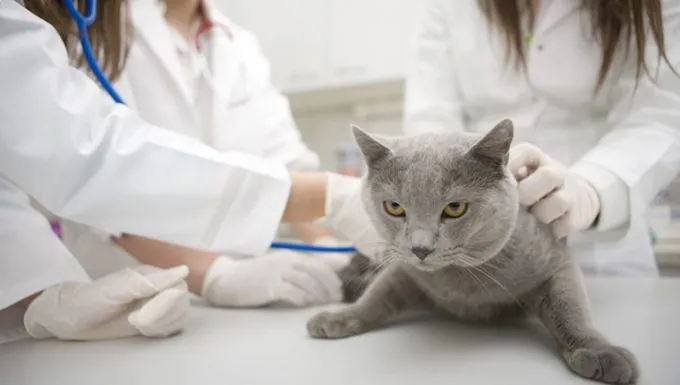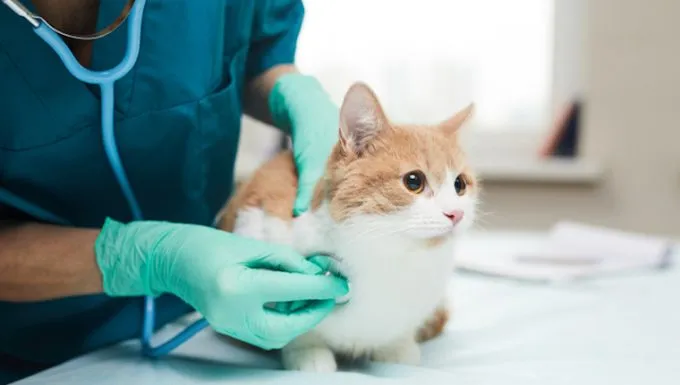Causes of Excess Calcium in the Blood
Primary Hyperparathyroidism: A Leading Cause

The causes of excess calcium in the blood, also known as hypercalcemia, are multifaceted and can be attributed to several underlying conditions.
One of the leading causes of hypercalcemia in cats is primary hyperparathyroidism (PHPT), a condition where one or more parathyroid glands become overactive and secrete excess parathyroid hormone (PTH).
This excessive production of PTH leads to an increase in calcium levels in the blood, causing various systemic effects on the body.
PHPT is characterized by:
The overproduction of PTH, leading to increased bone resorption and calcium mobilization from bones
Increased renal tubular reabsorption of calcium in the kidneys
Reduced excretion of phosphorus, leading to hyperphosphatemia
PHPT can be caused by various factors, including:
A genetic predisposition to PHPT, which is a common cause in older cats
Benign growths or tumors on the parathyroid glands, which stimulate excessive PTH production
Secondary causes such as hyperthyroidism, kidney disease, or vitamin D toxicity
The clinical manifestations of PHPT can be variable and may include:
Muscle weakness and tremors
Lethargy and loss of appetite
Kidney stone formation due to increased calcium levels in the urine
Nephrocalcinosis, a condition characterized by deposits of calcium salts in the kidney tissue
A definitive diagnosis of PHPT can be made through:
Complete blood count (CBC) and serum chemistry profile to assess for hypercalcemia, anemia, and electrolyte imbalances
Urinalysis to evaluate kidney function and detect proteinuria or hematuria
Radiographic imaging such as radiographs, ultrasonography, or computed tomography (CT) scans to visualize the parathyroid glands and kidneys
Imaging-guided fine-needle aspiration biopsy of the suspected parathyroid gland or kidney tissue for histopathological evaluation
The primary goal in managing PHPT is to reduce the elevated PTH levels, alleviate symptoms, and prevent complications.
Clinical treatment may involve:
Medical therapy with bisphosphonates or calcimimetics to decrease PTH secretion
Surgical removal of the overactive parathyroid gland(s) in cats that are suitable candidates
Palliative care and supportive measures to manage symptoms and prevent kidney damage
Prognosis depends on factors such as the severity of hypercalcemia, presence of kidney disease, and effectiveness of treatment.
Cats with mild PHPT may have a better prognosis with medical therapy, while cats with more severe disease or significant renal impairment may have a poorer outcome despite surgical intervention.
This condition occurs when one or more of a cat’s parathyroid glands become overactive, producing excess parathyroid hormone (PTH) and leading to increased calcium levels.
The primary cause of excess calcium in the blood (hypercalcemia) in cats is the overactivity of one or more parathyroid glands.
Normally, these small endocrine glands located near the thyroid gland produce a hormone called parathyroid hormone (PTH), which plays a crucial role in regulating calcium levels in the body by stimulating its release from bones and increasing its absorption in the gut.
In some cases, one or more of these glands can become overactive and produce excessive amounts of PTH. This condition is known as primary hyperparathyroidism.
When excess PTH is released into the bloodstream, it leads to an increase in calcium levels. If left untreated, this can cause a range of health problems for cats, including kidney damage, bone disease, and other systemic issues.
There are several factors that may contribute to the development of primary hyperparathyroidism in cats:
Aging: The condition is more common in older cats. As cats age, their parathyroid glands can become less efficient and produce excess PTH.
Genetics: Some breeds are more prone to developing primary hyperparathyroidism due to genetic predisposition.
Dietary factors: Cats fed a high-calcium diet or those with access to calcium supplements may be at increased risk of developing excess PTH production.
Secondary hyperparathyroidism, another condition that can lead to excess calcium in the blood, is often caused by an underlying health issue, such as:
Kidney disease or kidney failure: In these cases, the kidneys are unable to process waste products and maintain proper calcium levels.
Hyperthyroidism: Cats with an overactive thyroid gland may experience increased PTH production, leading to excess calcium in the blood.
Milk-Feeding Disorders (MFDs): This condition affects cats fed milk or formula containing high levels of phosphorus and can lead to secondary hyperparathyroidism.
According to the Cornell University College of Veterinary Medicine, primary hyperparathyroidism is the most common cause of hypercalcemia in cats.
Causes of Excess Calcium in the Blood in Cats:
Excess calcium in the blood, also known as hypercalcemia, can be a serious and potentially life-threatening condition in cats. According to Cornell University College of Veterinary Medicine, primary hyperparathyroidism is the most common cause of hypercalcemia in cats.
Primary hyperparathyroidism occurs when one or more of a cat’s parathyroid glands become overactive and start producing excess parathyroid hormone (PTH). This excess PTH triggers the body to release too much calcium from the bones into the bloodstream, leading to hypercalcemia.
Certain kidney diseases can also cause excess calcium in the blood. When kidneys are not functioning properly, they may lose their ability to remove excess calcium from the blood. Additionally, certain tumors, such as lymphoma or multiple myeloma, can produce excessive amounts of parathyroid hormone or other substances that stimulate calcium release.
Other causes of hypercalcemia in cats include:
Hypervitaminosis D: This condition occurs when a cat is exposed to high levels of vitamin D, which can stimulate the body to absorb too much calcium from the diet. This can happen if a cat eats contaminated food or has access to vitamin D-containing substances.
Prolactinoma: A type of pituitary tumor that can produce excess prolactin hormone, leading to hypercalcemia.
Certain medications: Long-term use of certain medications, such as steroids and certain antibiotics, can cause hypercalcemia in cats. These medications should only be used under the guidance of a veterinarian.
Genetics: Some breeds, such as Siamese and Abyssinian cats, may be more prone to developing primary hyperparathyroidism due to their genetic makeup.
It is essential for cat owners to work closely with their veterinarian to diagnose and manage hypercalcemia. With prompt and proper treatment, many cats can recover from this condition and live long and healthy lives. However, in some cases, hypercalcemia may be a sign of an underlying serious disease, such as kidney failure or cancer.
Symptoms and Complications
From Kidney Damage to Bone Disease

Cats with excess calcium in their blood can exhibit a range of symptoms that vary depending on the severity and duration of the condition.
Mildly elevated calcium levels may not produce any noticeable signs or symptoms at first.
However, as the calcium levels continue to rise, cats may start to exhibit more severe symptoms such as vomiting, diarrhea, abdominal pain, lethargy, loss of appetite, and increased thirst and urination.
In some cases, cats with hypercalcemia may also experience tremors, seizures, or even coma if left untreated.
Chronic hypercalcemia can lead to more serious complications such as kidney damage or failure, which is often the result of decreased urine production and increased pressure within the kidneys.
The kidneys have a hard time filtering out excess calcium when there’s an overabundance of it in the blood, leading to renal insufficiency or even renal failure if left untreated.
Cats with chronic kidney disease due to hypercalcemia may require lifelong management and medication to control their condition.
Hyperparathyroidism, which is a common cause of excess calcium in cats, can also lead to secondary complications such as bone disease (renal osteodystrophy).
Renal osteodystrophy is a condition where the bones become soft or deformed due to an imbalance of minerals in the body, particularly calcium and phosphorus.
This leads to weakened bones that can cause pain, discomfort, and even deformities such as bowing legs, which can significantly impair a cat’s mobility and quality of life.
Excess calcium can damage a cat’s kidneys over time, leading to kidney disease or even failure.
Cats that suffer from excess calcium in their blood may exhibit a range of symptoms and complications.
The severity of these symptoms can vary depending on the underlying cause and duration of the condition.
Symptoms:
Increased thirst and urination
Polyuria, which is excessive urination that leads to accidents in the house.
Weight loss due to an inability to absorb nutrients from food.
Nausea and vomiting.
Poor appetite leading to weight loss over time.
The kidneys play a crucial role in maintaining calcium balance in the body.
Complications:
Excess calcium can damage a cat’s kidneys over time, leading to kidney disease or even failure.
This condition can also lead to secondary hyperparathyroidism, which causes the parathyroid glands to become overactive.
Secondary hyperparathyroidism leads to a cycle where high levels of calcium stimulate further secretion of parathyroid hormone (PTH).
Kidney Disease:
Kidney disease, also known as kidney failure, occurs when the kidneys can no longer function properly.
Causes damage to the kidneys’ ability to filter waste and excess fluids from the blood.
Long-term Effects:
The long-term effects of excess calcium in the blood can be devastating for cats.
Kidney failure can lead to a buildup of toxins in the body, causing further health problems.
Cats with kidney disease may experience symptoms such as vomiting, diarrhea, and lethargy.
Cats with hypercalcemia may also experience bone disease, such as osteodystrophy, which can cause pain and discomfort.

Cats with hypercalcemia may exhibit a range of symptoms that can be subtle but severe. As calcium levels build up in the blood, it can cause a variety of health problems and complications.
The most common symptoms of hypercalcemia in cats include:
vomiting and diarrhea
increased thirst and urination
weight loss
decreased appetite
restlessness and lethargy
In addition to these symptoms, cats with hypercalcemia may also experience bone disease, such as osteodystrophy, which can cause pain and discomfort. This is due to the high levels of calcium in the blood causing damage to the bones over time.
Osteodystrophy can lead to a range of complications, including:
softening or weakening of the bones
increased risk of fractures and osteoporosis
pain and discomfort in the affected areas
difficulty walking or standing due to pain or weakness
in some cases, permanent damage to the kidneys or other organs
It’s essential for cat owners to be aware of these symptoms and complications and seek veterinary care if they suspect their cat is suffering from hypercalcemia. A veterinarian can perform a range of tests to diagnose the condition and develop an effective treatment plan.
Treatments and Management Options
From Surgery to Dietary Changes
Excessive calcium levels in a cat’s blood can be caused by various factors, including hyperparathyroidism, kidney disease, and certain types of cancer.
Symptoms of excess calcium in cats include vomiting, diarrhea, abdominal pain, and lethargy, which can progress to more severe conditions such as seizures, muscle weakness, and heart arrhythmias if left untreated.
Hyperparathyroidism is a common cause of high blood calcium levels in cats, resulting from an overactive parathyroid gland that produces excess parathyroid hormone (PTH).
Cats with hyperparathyroidism may exhibit symptoms such as kidney disease, bone loss, and calcium deposits in tissues.
Other causes of elevated calcium levels in cats include kidney disease, which can lead to secondary hyperparathyroidism; certain types of cancer that stimulate PTH production; and primary hyperparathyroidism due to a benign tumor on one or more parathyroid glands.
A veterinarian’s diagnosis typically involves a physical examination, medical history, laboratory tests, imaging studies (e.g., radiographs, ultrasound), and sometimes exploratory surgery to investigate the underlying cause of elevated blood calcium levels.
Management options for cats with excess calcium in the blood depend on the underlying cause, but may include dietary changes, such as feeding a kidney-friendly diet to reduce PTH production and lower blood calcium levels.
Purportedly effective dietary modifications involve restricting phosphorus intake while increasing calcium absorption through nutritional supplements; however, these interventions require precise formulation under veterinary guidance to avoid further complications.
Medications may also be prescribed to help manage symptoms and underlying conditions associated with high blood calcium levels in cats, such as bisphosphonates (e.g., alendronate) to decrease bone resorption and lower PTH production, or diuretics (e.g., furosemide) to reduce fluid volume and electrolyte balance.
For cats with kidney disease, a veterinarian may recommend blood pressure management using vasodilators (e.g., hydralazine), a low-phosphorus diet, or phosphorus-reducing medications like sevelamer or lanthanum carbonate.
Cats with hyperparathyroidism may benefit from surgical intervention to remove one or more parathyroid glands to address the root cause of elevated blood calcium levels.
Surgery is typically a last resort, but when successful, it can help alleviate symptoms and improve overall quality of life for affected cats.
In some cases, surgery may be necessary to remove one or more of a cat’s parathyroid glands.
Cats with excess calcium in their blood may require immediate veterinary attention to prevent further complications and damage to the cat’s organs.
The treatment for hypercalcemia (excess calcium) in cats depends on the underlying cause and severity of the condition. In some cases, surgery may be necessary to remove one or more of a cat’s parathyroid glands.
Other management options include administering medications that help reduce calcium levels in the blood, such as bisphosphonates or corticosteroids.
Corticosteroids can also be used to decrease inflammation and reduce the risk of kidney damage. In cases where a cat’s parathyroid glands are overactive, radioactive iodine therapy may be necessary to destroy the abnormal tissue.
It is essential for cat owners to provide their cats with a nutritious diet that includes plenty of fresh water and a balanced mix of vitamins and minerals, as well as follow a regular exercise routine.
Monitoring blood calcium levels regularly can help identify if the treatment is effective in reducing hypercalcemia. Regular check-ups with a veterinarian are also crucial to ensure the condition does not worsen or lead to other complications.
The American Animal Hospital Association recommends dietary changes as part of the treatment plan for cats with excess calcium in the blood.
The American Animal Hospital Association recommends dietary changes as part of the treatment plan for cats with excess calcium in the blood. A balanced and nutritionally complete diet can help alleviate this condition.
Some key dietary modifications include:
Feeding a commercially available low-phosphorus cat food, which can help to reduce the amount of phosphorus being absorbed by the body.
Administering a calcium-restricted diet, as excessive calcium intake can exacerbate the condition.
Ensuring that fresh water is always available for drinking to prevent dehydration and help flush out toxins from the system.
In some cases, your veterinarian may also recommend a prescription diet specifically formulated to manage excess calcium in the blood. These diets are designed to minimize phosphorus absorption while providing essential nutrients for optimal health.
Medications may be prescribed to help alleviate symptoms and manage the condition. Common medications include:
Bisphosphonates, which can help reduce bone resorption and calcium levels in the blood.
Calcitonin or calcitriol, which can help regulate calcium metabolism and promote its excretion from the body.
Your veterinarian will work closely with you to determine the best course of treatment based on your cat’s individual needs and circumstances. Regular blood tests and monitoring of kidney function are crucial for ensuring that the condition is being effectively managed.
- Best Datanyze Alternatives for 2025 - April 19, 2025
- Best Leadfeeder Alternatives for 2025 - April 18, 2025
- Best LeadScrape Alternatives for 2025 - April 18, 2025



